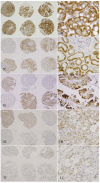High endogenous avidin binding activity: an inexpensive and readily available marker for the differential diagnosis of kidney neoplasms
- PMID: 18787626
- PMCID: PMC2480577
High endogenous avidin binding activity: an inexpensive and readily available marker for the differential diagnosis of kidney neoplasms
Abstract
It has been documented that some tissues, such as salivary gland, liver, cardiac and skeletal muscles and kidney, have high level endogenous biotin or endogenous avidin binding activity (EABA). Limited data is available on EABA in renal cell neoplasms. A tissue microarray (TMA) was constructed that included oncocytoma (n=30), chromophobe renal cell carcinoma (RCC) (n=18), clear cell RCC (n=45), clear cell RCC with granular/eosinophilic (G/E) features (n=19), papillary RCC (n=21), papillary RCC with G/E features (n=29) and benign renal tissues (n=31). The TMA slides were stained with or without biotin blocker and analyzed using the automated cellular imaging system (ACIS(R)). Without biotin blocker, a high positive rate of EABA was found in oncocytoma (56/60, 93%) and normal renal tubules (46/60, 77%). A moderate positive rate of EABA was found in clear cell and papillary RCCs with G/E features (13/39, 33% and 19/55, 35%, respectively). Chromophobe RCC and RCC without G/E features had essentially no EABA. With biotin blocker, benign renal tissue and clear cell RCC were negative for EABA; but a significant number of renal oncocytoma (29/60, 48%) and a few papillary RCC with G/E features (5/52, 10%) remained positive for EABA. In conclusion, high EABA may be used to differentiate oncocytoma from chromophobe RCC, and the staining results must be interpreted with caution when avidin-biotin detection system is used in diagnosing renal neoplasms.
Keywords: Oncocytoma; chromophobe renal cell carcinoma; endogenous avidin binding activity (EABA).
Figures


Similar articles
-
Oncocytoma can be differentiated from its renal cell carcinoma mimics by a panel of markers: an automated tissue microarray study.Appl Immunohistochem Mol Morphol. 2009 Jan;17(1):12-7. doi: 10.1097/PAI.0b013e318173e79d. Appl Immunohistochem Mol Morphol. 2009. PMID: 18769342
-
[The influence of heat-induced epitope retrieval on endogenous avidin-binding activity (EABA) and blocking of EABA in immunohistochemistry].Zhonghua Bing Li Xue Za Zhi. 2002 Dec;31(6):491-6. Zhonghua Bing Li Xue Za Zhi. 2002. PMID: 12622897 Chinese.
-
Endogenous avidin biotin activity (EABA) in thyroid pathology: immunohistochemical study.Thyroid Res. 2009 Apr 8;2(1):5. doi: 10.1186/1756-6614-2-5. Thyroid Res. 2009. PMID: 19351422 Free PMC article.
-
Immunohistochemical diagnosis of renal neoplasms.Arch Pathol Lab Med. 2011 Jan;135(1):92-109. doi: 10.5858/2010-0478-RAR.1. Arch Pathol Lab Med. 2011. PMID: 21204715 Review.
-
Primary collision tumors of the kidney composed of oncocytoma and papillary renal cell carcinoma: A review.Ann Diagn Pathol. 2017 Aug;29:32-36. doi: 10.1016/j.anndiagpath.2017.04.011. Epub 2017 May 2. Ann Diagn Pathol. 2017. PMID: 28807339 Review.
Cited by
-
Reduced expression of oestrogen receptor-β is associated with tumour invasion and metastasis in oestrogen receptor-α-negative human papillary thyroid carcinoma.Int J Exp Pathol. 2018 Feb;99(1):15-21. doi: 10.1111/iep.12266. Epub 2018 Apr 14. Int J Exp Pathol. 2018. PMID: 29655286 Free PMC article.
-
Differential expression patterns and clinical significance of estrogen receptor-α and β in papillary thyroid carcinoma.BMC Cancer. 2014 May 29;14:383. doi: 10.1186/1471-2407-14-383. BMC Cancer. 2014. PMID: 24884830 Free PMC article.
-
Endogenous biotin expression in renal and testicular tumours and literature review.Can Urol Assoc J. 2014 Jul;8(7-8):268-72. doi: 10.5489/cuaj.1810. Can Urol Assoc J. 2014. PMID: 25210551 Free PMC article.
References
-
- McCormick DB. Biotin. Nutr Rev. 1975;33:97–102. - PubMed
-
- Depeint F, Bruce WR, Shangari N, Mehta R, O'Brien PJ. Mitochondrial function and toxicity: role of the B vitamin family on mitochondrial energy metabolism. Chem Biol Interact. 2006;163:94–112. - PubMed
-
- Patard JJ, Leray E, Rioux-Leclercq N, Cindolo L, Ficarra V, Zisman A, De La Taille A, Tostain J, Artibani W, Abbou CC, Lobel B, Guille F, Chopin DK, Mulders PF, Wood CG, Swanson DA, Figlin RA, Belldegrun AS, Pantuck AJ. Prognostic value of histologic subtypes in renal cell carcinoma: a multicenter experience. J Clin Oncol. 2005;23:2763–2771. - PubMed
-
- Bussolati G, Gugliotta P, Volante M, Pace M, Papotti M. Retrieved endogenous biotin: a novel marker and a potential pitfall in diagnostic immunohistochemistry. Histopathology. 1997;31:400–407. - PubMed
-
- Parkin RK, Boeckh MJ, Erard V, Huang ML, Myerson D. Specific delineation of BK polyomavirus in kidney tissue with a digoxigenin-labeled DNA probe. Mol Cell Probes. 2005;19:87–92. - PubMed
LinkOut - more resources
Full Text Sources
